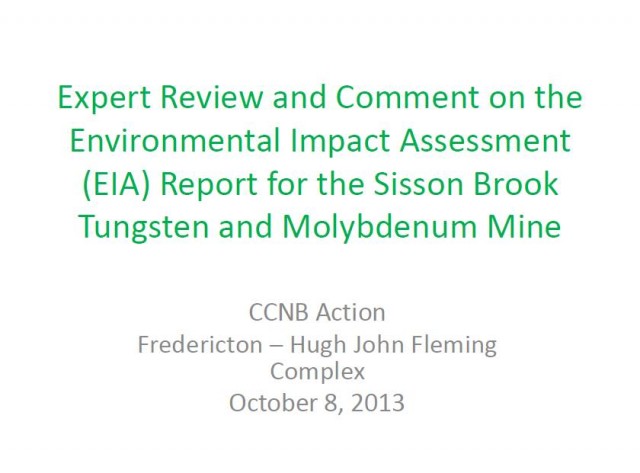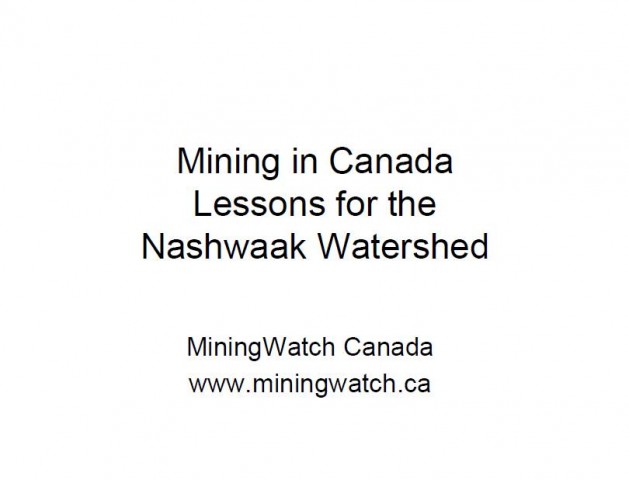Click here for the latest on the Sisson Mine Proposal.
Conservation Council of New Brunswick’s review of the Sisson mine project Provincial Environmental Impact Assessment report
CCNB comments on Sisson Brook EIA_July 17
Conservation Council of New Brunswick’s Review of Sisson mine project Federal Environmental Impact Assessment Report
Using participant funding provided by the Canadian Environmental Assessment Agency (CEAA), CCNB hired experts to review various sections of the federal Environmental Impact Assessment (EIA) report for the Sisson Project – Tungsten and Molybdenum mine. All public comments on the EIA report for the Sisson Project were submitted to the Canadian Environmental Assessment Agency (CEA Agency) before October 14, 2013.
Cover letter to CEA Agency from CCNB Action
Review of the Sisson Environmental Impact Assessment Report
To make CCNB’s Expert Comments Report on the Environmental Impact Assessment report for the Sisson Mine Project easier to read, it has been made into five smaller reports.
1. EIA Report Section 8.2 Atmospheric Environment
EIA Report Section 8.9 – Public Health
2. EIA Report Section 8.4_- Water Resource
EIA Report Section 8.5_- Aquatic Environment
3. EIA Report Section 8.6 – Terresterial Environment
EIA Report Section 8.7 – Vegetated Environment
EIA Report Section 8.8 – Wetland Environment
4. re: EIA Report Section 8.10 – Labour and the Economy
5. EIA Report Section 2.0 – Need for Sustainability of Project, etc.
EIA Report Section 3.0 – Mine Design and Technology
EIA Report Section 8.17 – Accidents and Malfunctions
Conceptual Decommissioning, Closure and Reclamation Plan
For more information on the project, check out these presentations given at community sessions in Stanley, Fredericton and Taymouth in the fall of 2013.
A summary of the EIA report can be found at:
http://www.ceaa-acee.gc.ca/050/documents/p63169/93969E.pdf
The complete EIA report and supporting background studies can be found at:
http://www.ceaa-acee.gc.ca/050/document-eng.cfm?document=93967
About the Project
The Sisson mine project is a proposal for one of the worlds largest open pit mines for tungsten and molybdenum. If it goes ahead, it will be dug out of the heart of the upper Nashwaak River valley near Stanley.
The potential for the Sisson mine first appeared publicly in 2008 and has moved slowly since. The project has changed hands once already; Northcliff Resources is the current proponent whose only project is the Sisson mine proposal.
The project is underwent a harmonized provincial and federal Environmental Assessment process which was open for public comment until October 14, 2013.
According to available information, the proposed Sisson mine project will include:
- 8 km of dams (the Mactaquac Dam is 0.5 km long)
- approximately 87 m dam height at the deepest point (the Mactaquac Dam is 40-50 m high)
- approximately 145 ha open-pit, 370m deep
- 751 ha tailing impoundment (TSF)
- 2011 million cubic m. of tailings at maximum storage
- 181 million cubic m. of waste rock and stored ore.
- A tailing impoundment volume of 350 million cu.m.
- Capture of all precipitation from 800-900 ha for 27 years
- 30,000 tons of ore processed daily for 27 years
- An additional 30,000 tons of waste rock generated daily for 27 years
- The mine would require at least $579 million in capital investment
- The company claims 500 jobs during the two year mine construction.
- The company claims 307 total jobs at startup
Some consequences of these specifics are:
- Generation of 290 million cubic metres of tailings over 27 years with grain size 0-100 microns in diameter (8-10% < 2.5 microns, 20-25%< 10 microns and 40-50% < 30 microns)
- After year 8, there will be a generation of an average of 6 million cubic metres per year of contaminated waste water requiring treatment, the equivalent of 16,500 cubic metres per day.
- The water emissions from this mine constitute a new point source of emissions into a Class A Stream. Under the Classification Regulation of the Clean Water Act, a new point source into a Class A Stream is prohibited. However, the classification of the Nashwaak has never been finalized.
- From prospecting records, an estimated 44,000 tons of arsenic will be generated every year within the mine tailings, in the form of very fine silt and sand (121 tons per day)
- Wind and water emissions from the mine site will have an estimated composition of 4020 ppm of Arsenic; CCME guidelines for arsenic in soil and sediment are 12-17 ppm.
- Based on recent studies, the wind emission footprint of this mine will exceed 20km downwind and downstream. The arsenic content of these emissions will be a threat to aquatic and terrestrial life including human habitation
- Based on historical performance, the tailing dam will have a 1 in 700 to 1 in 1750 chance of failing every year.
- Based on historical performance, the run-out of slurry from the failure of a tailing dam of this height would extend 25-30km downstream (The Village of Stanley is 19km from the mine site)
- Based on historical performance, the failure of a tailing dam impounding 290 million cu.m of tailings would release 58 million cu.m of slurry and the run-out would extend more than 100 km downstream.(The St. John River at Fredericton is 60 km from the mine site)
- To get this project off the ground, the province would need to invest an estimated $100 million in road upgrades and bridge replacements.
- To be attractive to investors, the province would have to subsidize electricity to the site to the tune of $8 million per year.
- To be attractive to investors, the mine would need to exploit the richest veins in the first three years. The remaining 24 years of operation would be proportionally economically challenged.
- No royalties are collected on metallic mineral exploitation in New Brunswick, thus no royalties for the 27 year operation of the mine.
- There is a 2% tax on net revenue from the mine with a two year start-up exemption from the tax.
- In year three, there would be an additional 16% tax on net profit with a write-off of 5% of capital expenditure.
- If everything proceeds as planned, the mine would average an estimated $14 million/yr in metallic mineral tax over the 27 year lifetime.
- Computer modeling of a tailing dam failure at Sisson has shown that there would likely be a deposition of arsenic contaminated tailings blocking the Nashwaak for the foreseeable future, constituting an unconfined tailing dump for centuries.
- No provision or cost has been made suggested for remediation of a catastrophic failure of the tailing dam. The taxpayer will assume the liability for any expense in excess of the proponent’s ability to pay.
- Bonding is only required for post closure reclamation. Historical bonding at Rio Tinto mines has averaged $143 million. No bond of this size has ever been required of a mine in New Brunswick.
- Bonding is accumulated incrementally yearly. However, the environmental footprint reaches full-scale very quickly. If closure occurs before the projected 27 year life expectancy, in-place bonding will be inadequate for reclamation. The taxpayer will assume the excess liability.
For more information on this proposed project please contact Stephanie Merrill; water@conservationcouncil.ca


